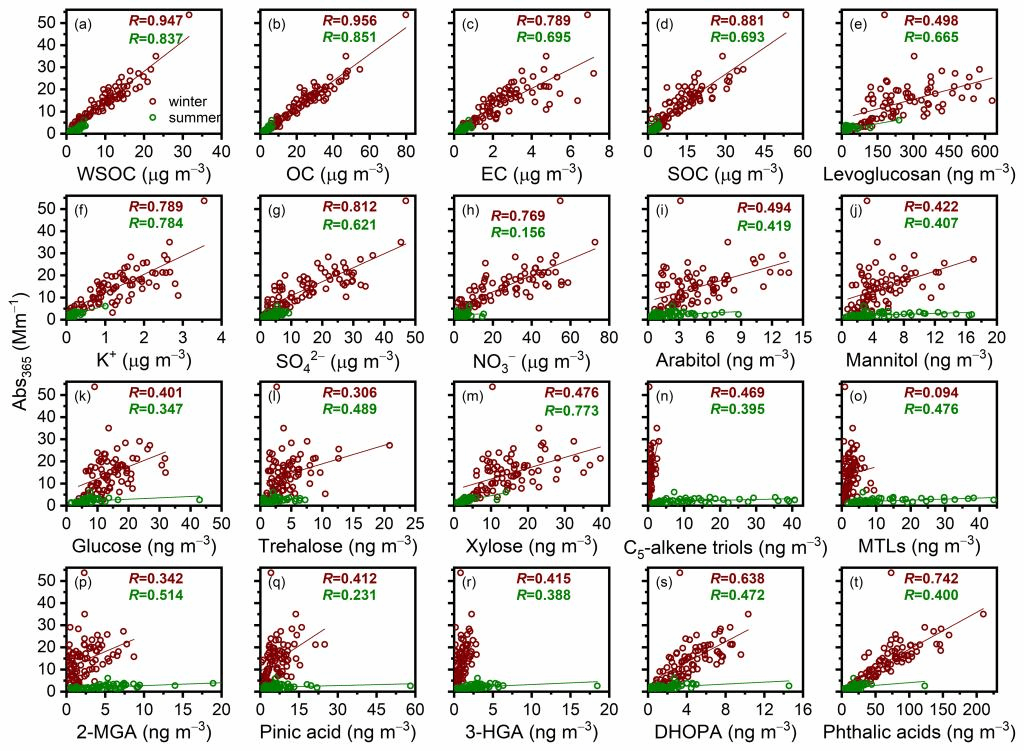Brown carbon (BrC) aerosols exert vital impacts on climate change and atmospheric photochemistry due to their light absorption in the wavelength range from near-ultraviolet (UV) to visible light. However, the optical properties and formation mechanisms of ambient BrC remain poorly understood, limiting the estimation of their radiative forcing. In the present study, fine particles (PM2.5) were collected during 2016–2017 on a day/night basis over urban Tianjin, a megacity in northern China. Light absorption and fluorescence properties of water extracts of PM2.5 were investigated to obtain seasonal and diurnal patterns of atmospheric water-soluble BrC. There were obvious seasonal, but no evident diurnal, variations in the light absorption properties of BrC. In winter, BrC showed much stronger light-absorbing ability. Direct radiative effects by BrC absorption relative to black carbon in the UV range were 54.3±16.9%and 44.6±13.9% in winter and summer, respectively. In addition, five fluorescent components in BrC, including three humic-like fluorophores and two protein-like fluorophores were identified with excitation–emission matrix fluorescence spectrometry and parallel factor analysis. The less oxygenated components contributed more to winter and nighttime samples, while more oxygenated components increased in summer and daytime samples. The higher humification index, together with lower biological index and fluorescence index, suggests that the chemical compositions of BrC were associated with a high aromaticity degree in summer and daytime due to photobleaching. Fluorescent properties indicate that wintertime BrC were predominantly affected by primary emissions and fresh secondary organic aerosol (SOA), while summer ones were more influenced by aging processes. Results of source apportionments using organic molecular compositions of the same set of aerosols reveal that fossil fuel combustion and aging processes, primary bioaerosol emission, biomass burning, and biogenic and anthropogenic SOA formation were the main sources of BrC. Biomass burning contributed much more to BrC in winter and at nighttime, while biogenic SOA contributed more in summer and during the daytime. In particular, our study highlights that primary bioaerosol emission is an important source of BrC in urban Tianjin in summer.

Figure 1. Relationships between BrC and chemical species of aerosols in Tianjin

Figure 2. Relative contributions of individual sources to BrC
Article Information:Junjun Deng, Hao Ma, Xinfeng Wang, Shujun Zhong, Zhimin Zhang, Jialei Zhu, Yanbing Fan, Wei Hu, Libin Wu, Xiaodong Li, Lujie Ren, Chandra Mouli Pavuluri, Xiaole Pan, Yele Sun, Zifa Wang, Kimitaka Kawamura, and Pingqing Fu*. 2022. Measurement report: Optical properties and sources of water-soluble brown carbon in Tianjin, North China – insights from organic molecular compositions. Atmospheric Chemistry and Physics, 22, 6449–6470.
Article link: https://doi.org/10.5194/acp-22-6449-2022.